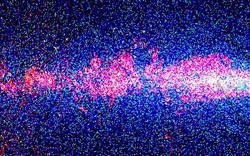Radiation scattered by galactic dust provides valuable clues to galactic star formation

Fig. 1: A small part of the galactic map constructed from AKARI data. Red represents stellar emissions affected by dust.
c 2010 JAXA
To understand ancient fundamental processes such as the formation of elements heavier than helium and the evolution of large structures in the Universe, it is important to document the history of star formation in galaxies. Tsutomu T. Takeuchi, Katsuhiro L. Murata and Yuan Fang-Ting from Nagoya University and colleagues from Spain, the USA and France1 have now produced a map of star formation across the Universe with unprecedented precision, providing a valuable resource for the study of star formation.
Unlike our own sun with its yellow appearance, some of the more massive, fast-burning stars in our nearby galaxies emit intense ultraviolet (UV) radiation. The emission of these stars has been studied using NASA's GALEX satellite launched in 2003. Unfortunately, the GALEX mapping remains incomplete.
"The UV emission is easily scattered and absorbed by interstellar dust grains," says Takeuchi, a member of Nagoya University's Institute of Advanced Research. Once absorbed by dust, however, the UV radiation is reemitted as infrared (IR) light, which can be mapped using the Japan Aerospace Exploration Agency's AKARI satellite launched in 2006 (Fig. 1).
Takeuchi and his co-workers have now combined the UV data from GALEX with the IR data from AKARI to construct a precise picture of star formation through 607 galaxies. Their analysis has uncovered a number of new findings. Most importantly, the overall color of local 'dusty' galaxies is neither blue -- as the UV light from the young stars would suggest -- nor red like the emission from more mature stars such as the Sun. Instead, these galaxies have colors somewhere in between. Understanding this unusual spectral energy distribution will be crucial for explaining how galaxies have evolved.
The comparison of the UV and IR data also revealed that a large majority of young stars are hidden from our direct view by dust. "It is surprising that such a large amount of dust should have formed during a very short timescale of the Universe in its 'middle age'," says Takeuchi. "The first stars contained no heavy elements, and we would expect there to be less dust. Hence, there must have been quite an early transition from a transparent universe to the present dusty universe."
To address such fundamental questions, scientists will need to look deeper into the earliest history of the Universe. Indeed, the Herschel Space Telescope is presently surveying the Universe at longer IR wavelengths than is possible with AKARI in the hope of revealing the regions where star formation in the earliest galaxies can be observed. From this data, according to Takeuchi, "a thorough scenario of galaxy formation and evolution can be constructed."
Affiliated Researchers
The Nagoya University affiliated researchers mentioned in this highlight are from the Institute for Advanced Research (IAR) and the Division of Particle and Astrophysical Science.
Reference
- Takeuchi, T. T., Buat, V., Heinis, S., Giovannoli, E., Yuan, F.-T., Iglesias-Paramo, J., Murata, K. L. & Burgarella, D. Star formation and dust extinction properties of local galaxies from the AKARI-GALEX all-sky surveys. Astronomy & Astrophysics 514, A4 (2010). | article